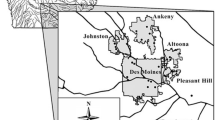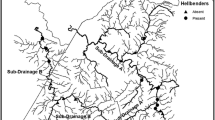Abstract
The general hypothesis that catchment urbanization explained the distribution of the threatened, stream-dwelling amphipod Austrogammarus australis (listed under the Victorian Flora and Fauna Guarantee Act 1988) was tested using several surveys of 58 sites in streams draining the Dandenong Ranges on the eastern fringe of Melbourne, Victoria, Australia. More specifically, four catchment-scale elements of urban land, hypothesized as sources of stress to receiving streams, were separated: catchment imperviousness, drainage connection (proportion of impervious areas connected to streams by stormwater pipes), density of unsealed roads and density of septic tanks. The degree to which each attribute independently and jointly explained the occurrence of A. australis was assessed using hierarchical partitioning of logistic regression analyses. Drainage connection independently best explained the occurrence of A. australis, pointing to stormwater drainage design as the priority area of catchment management for the conservation of the species. The separation of urban land use into attributes that characterize likely stressor sources provides a useful framework for assessing and prioritizing the most appropriate management actions to minimize urban-related stresses to aquatic biota.
Similar content being viewed by others
References
Allan J.D. and Flecker A.S. 1993. Biodiversity conservation in running waters. BioScience 43: 32–43.
Arnold C.L. Jr. and Gibbons C.J. 1996. Impervious surface coverage: The emergence of a key environmental indicator. Journal of the American Planning Association 62: 243–258.
Booth D.B. and Jackson C.R. 1997. Urbanization of aquatic systems-degradation thresholds, storm-water detention, and the limits of mitigation. Journal of the American Water Resources Association 33: 1077–1090.
Chevan A. and Sutherland M. 1991. Hierarchical partitioning. The American Statistician 45: 90–96.
CNR 1995. Threatened Fauna in Victoria. Department of Conservation and Natural Resources, Melbourne, Victoria, Australia.
Collier K.J. 1995. Environmental factors affecting the taxonomic composition of aquatic macroinvertebrate communities in lowland waterways of Northland, New Zealand. New Zealand Journal of Marine and Freshwater Research 29: 453–465.
Doeg T. and Papas P. 2000. The Dandenong Freshwater Amphipod Austrogammarus australis. Flora and Fauna Guarantee Action Statement 3. Department of Natural Resources and Environment, Melbourne, Victoria, Australia.
Doeg T.J., Tsyrlin E. and van Praagh B. 1996. A survey for the Dandenong freshwater amphipod Austrogammarus australis (Sayce). Final Report. Freshwater Ecology Section, Flora and Fauna Branch, Department of Natural Resources and Environment, Melbourne, Victoria, Australia.
Duncan H.P. 1995. A Review of Urban Storm Water Quality Processes. Cooperative Research Centre for Catchment Hydrology, Melbourne, Australia.
Eaglin G.S. and Hubert W.A. 1993. Effects of logging and roads on substrate and trout in streams of the Medicine Bow National Forest, Wyoming. North American Journal of Fisheries Management 13: 844–846.
Hammer T.R. 1972. Stream channel enlargement due to urbanization. Water Resources Research 8: 1530–1540.
Hastie T.J. and Tibshirani R.J. 1990. Generalized Additive Models. Chapman & Hall, London.
Horner R.R. and Mar B.W. 1983. Guide for assessing water-quality impacts of highway operations and maintenance. Transportation Research Record 948: 31–39.
Horwitz P. 1990. The Conservation Status of Australian Freshwater Crustacea. Report 14. Australian National Parks and Wildlife Service, Canberra, Australia.
Lambeck R.J. 1997. Focal species-a multi-species umbrella for nature conservation. Conservation Biology 11: 849–856.
Leopold L.B. 1968. Hydrology for Urban Land Planning: A Guidebook on the Hydrological Effects of Urban Land Use. Circular 554. US Geological Survey, Washington, DC.
Mac Nally R. 2000. Regression and model building in conservation biology, biogeography and ecology: the distinction between-and reconciliation of-'predictive' and explanatory models. Biodiversity and Conservation 9: 655–671.
McIntyre N.E., Knowles-Yánez K. and Hope D. 2000. Urban ecology as an interdisciplinary field: differences in the use of 'urban' between the social and natural sciences. Urban Ecosystems 4: 5–24.
McMahon G. and Cuffney T.F. 2000. Quantifying urban intensity in drainage basins for assessing ecological conditions. Journal of the American Water Resources Association 36: 1247–1261.
Medeiros C., LeBlanc R. and Coler R.A. 1983. An in situ assessment of the acute toxicity of urban runoff to benthic macroinvertebrates. Environmental Toxicology and Chemistry 2: 119–126.
Melbourne Water Corporation 2001. Corhanwarrabul Creek waterway management activity plan report. Report by Thompson Berrill Landscape Design Pty Ltd and Fluvial Systems Pty Ltd. Melbourne Water Corporation, Melbourne, Australia.
Miller R.R., WiIliams J.D. and Williams J.E. 1989. Extinctions of North American fishes during the past century. Fisheries 14: 22–38.
Morley S.A. and Karr J.R. 2002. Assessing and restoring the health of urban streams in the Puget Sound Basin. Conservation Biology 16: 1498–1509.
Naiman R.J., Magnuson J.J., McKnight P.M. and Stanford J.A. 1995. The Freshwater Imperative. Islands Press, Washington, DC.
Neller R.J. 1989. Induced channel enlargement in small urban catchments, Armidale, New SouthWales. Environmental Geology and Water Sciences 14: 167–172.
Novotny V. and Olem H. 1994. Water Quality. Prevention, Identification, and Management of Diffuse Pollution. Van Nostrand Reinhold, New York.
Papas P.J., Crowther D. and Kefford B.J. 1999. Second survey for the Dandenong freshwater amphipod Austrogammarus australis (Sayce) with observations on the effect of the William Ricketts Sanctuary carpark oil spill on the amphipod. Department of Natural Resources and Environment, Melbourne, Victoria, Australia.
Paul M.J. and Meyer J.L. 2001. Streams in the urban landscape. Annual Review of Ecology and Systematics 32: 333–365.
Pedersen E.R. and Perkins M.A. 1986. The use of benthic invertebrate data for evaluating impacts of urban runoff. Hydrobiologia 139: 13–22.
Poff N.L., Allan J.D., Bain M.B., Karr J.R., Prestegaard K.L., Richter B.D. et al. 1997. The natural flow regime. BioScience 47: 769–784.
Pratt J.M., Coler R.A. and Godfrey P.J. 1981. Ecological effects of urban stormwater runoff on benthic macroinvertebrates inhabiting the Green River, Massachusetts. Hydrobiologia 83: 29–42.
Reid L.M. and Dunne T. 1984. Sediment production from forest road surfaces.Water Resources Research 20: 1753–1761.
Richter B.D., Braun D.P., Mendelson M.A. and Master L.L. 1997. Threats to Imperiled Freshwater Fauna. Conservation Biology 11: 1081–1093.
Rigg J.M. 1978. Sullage quality characterisation for a low-density housing development, M.Env.Sc. Thesis, Monash University, Melbourne, Australia.
Riley S.J. and Banks R.G. 1996. The role of phosphorus and heavy metals in the spread of weeds in urban bushlands-an example from the Lane Cove valley, NSW, Australia. Science of the Total Environment 182: 39–52.
Saunders D.L., Meeuwig J.J. and Vincent A.C.J. 2002. Freshwater protected areas: strategies for conservation. Conservation Biology 16: 30–41.
Sayce O.A. 1901. Description of some new Victorian freshwater Amphiphoda. Proceedings of the Royal Society of Victoria 12: 152–159.
Schueler T.R. 1994. The importance of imperviousness. Watershed Protection Techniques 1: 100–111.
Schueler T. and Claytor R. 1997. Impervious cover as a urban stream indicator and a watershed management tool. In: Roesner L.A. (ed.), Effects of Watershed Development and Management on Aquatic Ecosystems.: Proceedings of an Engineering Foundation Conference. American Society of Civil Engineers, New York, Snowbird, Utah, pp. 513–529.
Victorian Stormwater Committee 1999. Urban Stormwater: Best Practice Environmental Management Guidelines. Victorian Stormwater Committee, CSIRO Publishing, Melbourne, Australia.
Walsh C.J. 2000. Urban impacts on the ecology of receiving waters: a framework for assessment, conservation and restoration. Hydrobiologia 431: 107–114.
Walsh C.J. and Breen P.F. 2001. A biological approach to assessing the potential success of habitat restoration in urban streams. Verhandlungen Internationale Vereinigung für Theoretische und Angewandte Limnologie 27: 3654–3658.
Walsh C.J., Sharpe A.K., Breen P.F. and Sonneman J.A. 2001. Effects of urbanization on streams of the Melbourne region, Victoria, Australia. I. Benthic macroinvertebrate communities. Freshwater Biology 46: 535–551.
Williams W.D. and Barnard J.L. 1988. The taxonomy of crangonyctoid Amphipoda (Crustacea) from Australian fresh waters: foundation studies. Records of the Australian Museum Supplement 10: 1–180.
Author information
Authors and Affiliations
Corresponding author
Rights and permissions
About this article
Cite this article
Walsh, C.J., Papas, P.J., Crowther, D. et al. Stormwater drainage pipes as a threat to a stream-dwelling amphipod of conservation significance, Austrogammarus australis, in southeastern Australia. Biodiversity and Conservation 13, 781–793 (2004). https://doi.org/10.1023/B:BIOC.0000011726.38121.b0
Issue Date:
DOI: https://doi.org/10.1023/B:BIOC.0000011726.38121.b0




